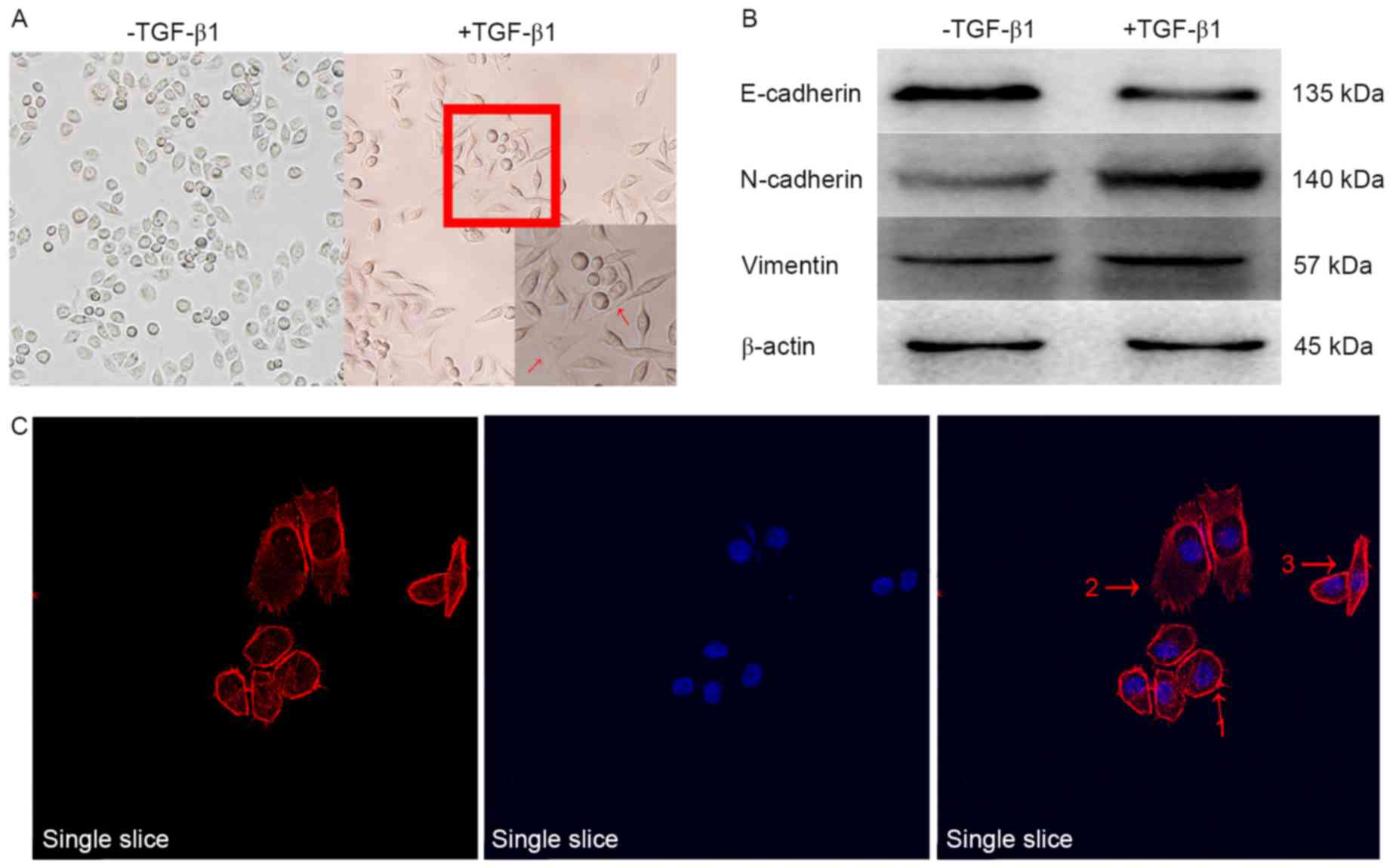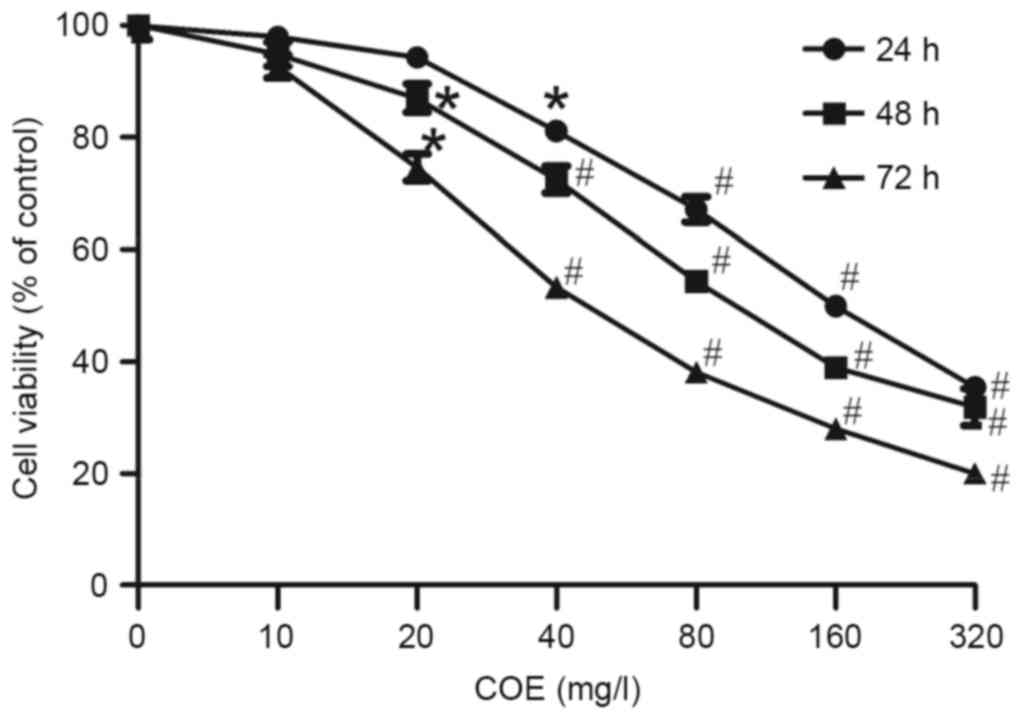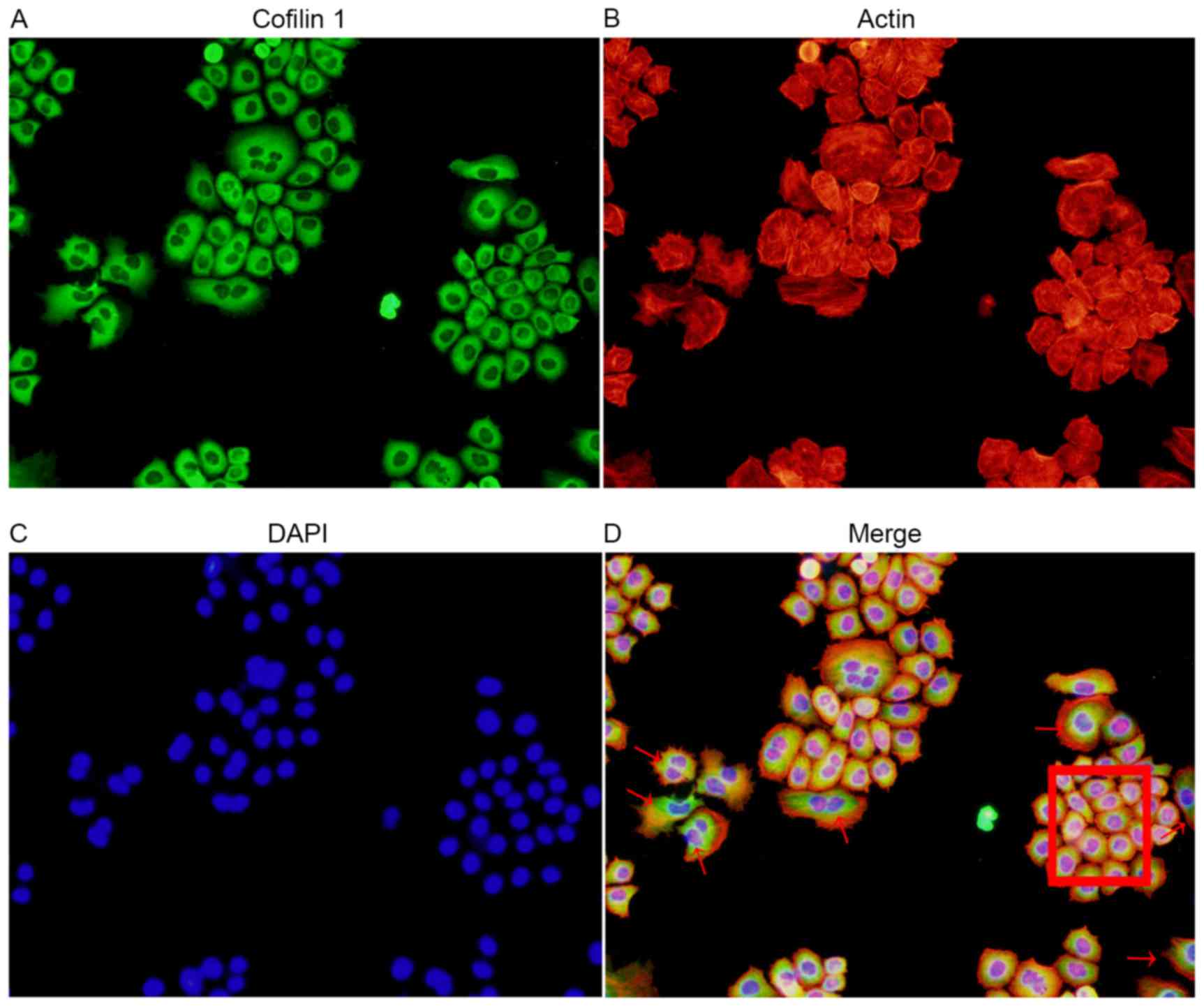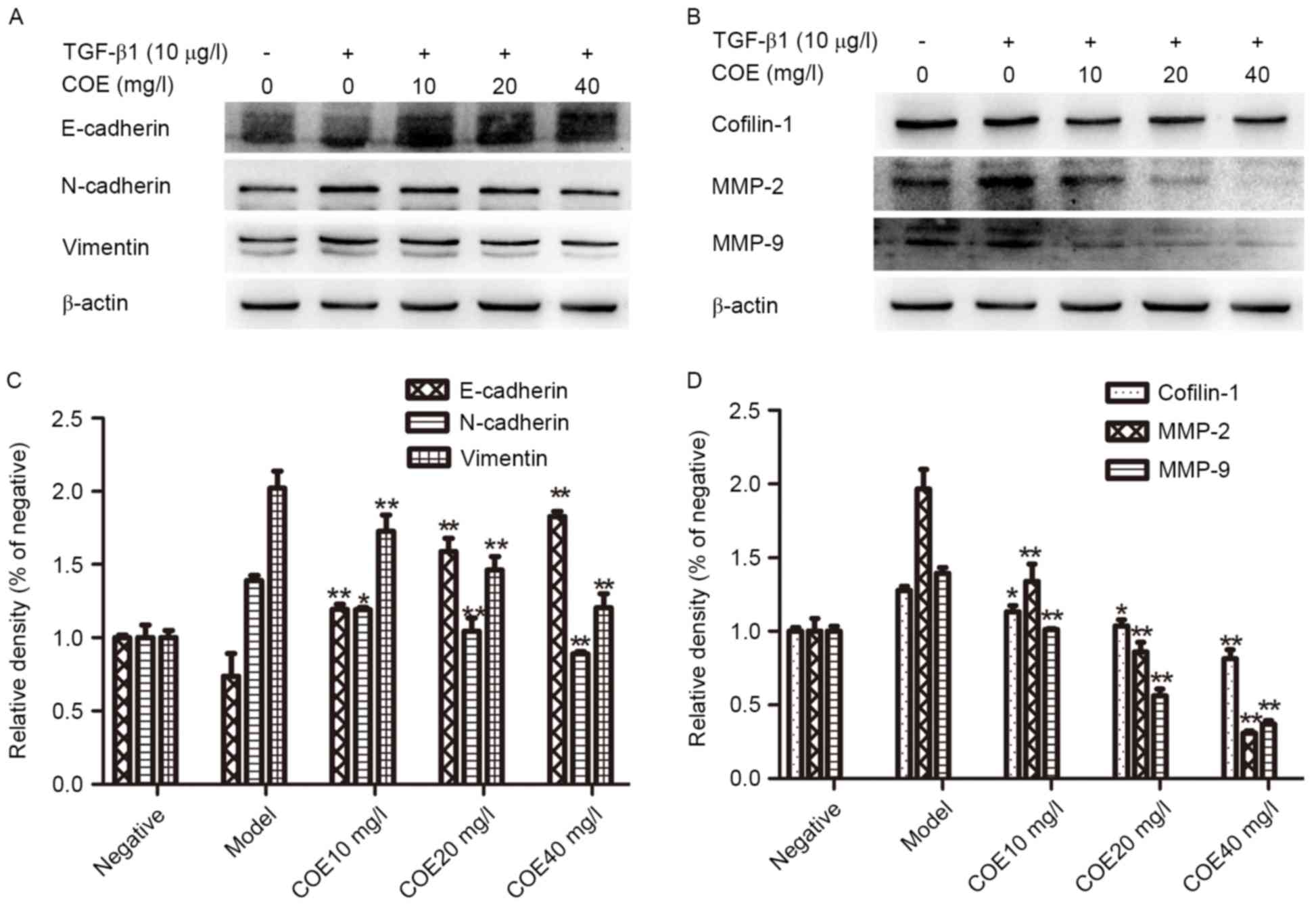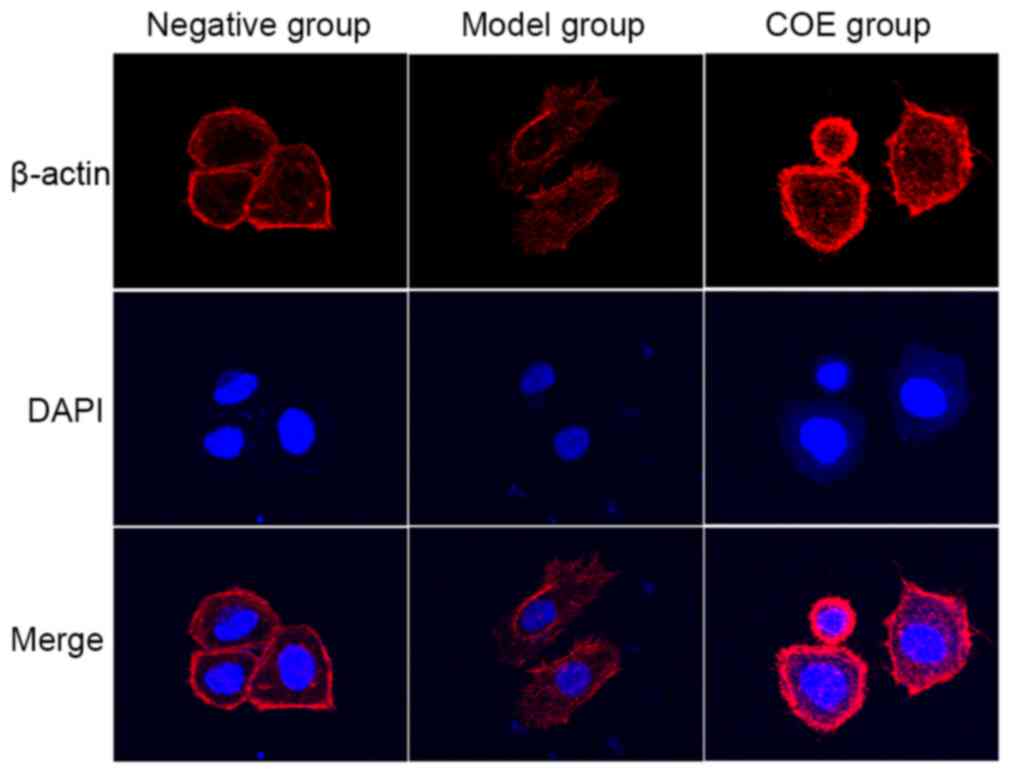Celastrus orbiculatus extract suppresses the epithelial-mesenchymal transition by mediating cytoskeleton rearrangement via inhibition of the Cofilin 1 signaling pathway in human gastric cancer
- Authors:
- Published online on: June 23, 2017 https://doi.org/10.3892/ol.2017.6470
- Pages: 2926-2932
-
Copyright: © Wang et al. This is an open access article distributed under the terms of Creative Commons Attribution License.
Abstract
Introduction
Gastric cancer has one of the highest incidence rates of all types of cancer globally, and the second highest mortality rate of all types of malignant tumor (1). As gastric cancer is frequently asymptomatic, the majority of tumor invasion and metastasis events occur prior to diagnosis of the patient at hospital. The high incidence of tumor metastasis and low sensitivity to chemotherapy in gastric cancer are important factors that restrict the improvement of gastric cancer survival rates (2). Epithelial-mesenchymal transition (EMT) is an important biological process through which malignant tumor cells derived from the epithelium obtain migration and invasion abilities. Following EMT, tumor cells lose epithelial cell polarity and their connection to the basement membrane, while their migration and invasion abilities, resistance to apoptosis and ability to degrade the extracellular matrix (ECM) are enhanced (3). Cofilin 1 is an important regulatory factor of EMT in tumor cells, demonstrating an association with the occurrence and development of tumors (4–6). Cofilin 1 may become a novel target for the treatment of malignant tumor growth and metastasis (7–10). Celastrus orbiculatus Thunb, a member of the Celastraceae family, is an important medicinal plant in China. Preliminary experimental studies have identified that the ethyl acetate extract of C. orbiculatus Thunb (COE) may significantly inhibit the proliferation, EMT, invasion and metastasis abilities of tumor cells (11,12). However, the molecular mechanisms underlying the inhibition of EMT in tumor cells by COE remains unclear, and studies investigating the regulation of EMT by COE through Cofilin 1 pathways in tumors have not been performed at present. Identifying the mechanisms underlying COE-induced inhibition of tumor EMT processes and metastasis has significance for the identification and development of novel antitumor agents in traditional Chinese medicine (TCM). On the basis of previous studies by our group (11,12), the present study examined EMT processes from the aspect of the cytoskeleton. The present study also revealed the mechanism underlying COE-induced inhibition of gastric cancer metastasis and invasion, which provides a basis for the development of novel antitumor TCM.
Materials and methods
Drugs
C. orbiculatus Thunb was purchased from Guangzhou Zhixin Pharmaceutical Co. Ltd. (Guangzhou, China) in July 2014 and stored at 4°C. It was identified as Celastraceae by Professor Qin Minjian of China Pharmaceutical University (Nanjing, China). The extraction, purification and identification of the COE compounds was performed as described previously (13). COE was prepared at the Department of Chinese Materia Medica Analysis, China Pharmaceutical University (Nanjing, China). A detailed description of the preparation procedure has been described previously (14,15). Briefly, dried stems of C. orbiculatus were pulverized and extracted using 95% ethanol 3 times; the final extract was obtained by filtering, removing ethanol, and vacuum cold-drying the final extracts at 4°C for 6 h. Finally, the extract was condensed, purified and lyophilized into powder at 4°C, and stored at 4°C thereafter. The COE micro-powder was dissolved in dimethyl sulfoxide (DMSO) to 1% and was further diluted with RPMI-1640 medium (Gibco; Thermo Fisher Scientific, Inc., Waltham, MA, USA) to different concentrations (10, 20, 40, 80, 160 and 320 mg/l) prior to use. The final concentration of DMSO in the medium did not exceed 0.1%.
Reagents and antibodies
RPMI-1640 medium and fetal bovine serum (FBS) were acquired from Gibco; Thermo Fisher Scientific, Inc. MTT and tetramethylrhodamine (TRITC)-conjugated Phalloidin, an actin staining agent, were purchased from Sigma-Aldrich; Merck KGaA (Darmstadt, Germany). Recombinant transforming growth factor (TGF)-β1 was obtained from R&D Systems, Inc. (Minneapolis, MN, USA). Matrigel was purchased from BD Biosciences (San Jose, CA, USA). Antibodies against epithelial (E)-cadherin (cat no. 3195), neural (N)-cadherin (cat no. 4061), Cofilin 1 (cat no. 5175), vimentin (cat no. 5741), MMP-2 (cat no. 4022), MMP-9 (cat no. 13667) and β-actin (cat no. 3700) were purchased from Cell Signaling Technology, Inc. (Danvers, MA, USA). Other chemicals used of analytical grade were from commercial sources.
Cell culture
Human gastric cancer AGS cells were acquired from the Cell Bank of Type Culture Collection of Chinese Academy of Sciences, Shanghai Institute of Cell Biology (Shanghai, China). AGS cells were cultured in RPMI-1640 medium containing 10% FBS and maintained at 37°C in a humidified incubator in an atmosphere of 5% CO2. Cell morphology was visualized at x100 magnification with an optical microscope (IX72; Olympus Corporation, Tokyo, Japan).
EMT model
105 AGS cells were seeded in 6-well plates for 12 h, then RPMI-1640 containing a concentration of 10 µg/l TGF-β1 was added into each well, and cultured at 37°C for an additional 24 h. To confirm the establishment of the model, the culture medium was removed, cells were washed twice with PBS and cell lysis buffer [20 mM Tris (pH 7.5), 150 mM NaCl, 1% Triton X-100] was added. After 15 min, all the liquid was collected into 1.5 ml EP tubes, and centrifuged at 8,000 x g at 4°C for 15 min. The BCA kit (Beyotime Institute of Biotechnology, Haimen, China) was used to quantify the protein, and total protein (50 µg) was separated using electrophoresis with a constant voltage of 110 V for 90 min in 10% SDS-PAGE gel. Following separation, proteins were transferred to a polyvinylidene (PVDF) membrane by electricity. The PVDF membrane was then washed 3 times, for 15 min each time, with 1X TBST (containing 0.1% Tween-20) wash buffer, then 5% skimmed milk powder solution was added for 2 h at room temperature. The membranes were subsequently washed again 3 times, for 15 min each time, with 1X TBST wash buffer. Primary antibodies were diluted to 1:1,000 with 5% skimmed milk powder solution and incubated with the membranes overnight at 4°C, which were then washed 3 times, for 15 min each time, with 1X TBST wash buffer. Secondary antibodies were diluted to 1:1,000 in 5% skimmed milk powder solution and incubated for 2 h at room temperature, then the membranes were washed 3 times, for 15 min each time, with 1X TBST wash buffer. A Bio-Rad protein gel imaging analysis system (Bio-Rad Laboratories, Inc., Hercules, CA, USA) was used to detect protein bands of the EMT biomarkers.
MTT measurement of cell viability and proliferation
AGS cells were plated at a density of 1,000 to 10,000 cells/well in a 96-well plate, and incubated at 37°C for 12 h. AGS cells were grouped into a negative control group (untreated), a model group (10 µg/l TGF-β1) and COE groups of different concentrations (10, 20, 40, 80 and 160 mg/l). The cells were cultured at 37°C for an additional 24, 48 or 72 h following the treatments. At 24, 48 or 72 h, cells were incubated with RPMI-1640 medium containing 0.5 mg/ml MTT at 37°C for 4 h. Formazan crystals were dissolved with 150 µl DMSO. The absorbance of each well, including blanks, was measured at 490 nm in an automatic microplate reader subsequent to 10 min oscillation. The formula of the cell growth inhibition rate was as follows: Inhibition rate = (1 - absorbance of COE group/absorbance of blank control group) x100%.
Cell invasion and migration assays
Cell invasion and migration assays were performed using a Transwell membrane (Corning Incorporated, Corning, NY, USA) according to the manufacturer's protocol. For the invasion assay, Matrigel was applied to the upper chamber. AGS cells (104) were seeded into the upper chamber and treated with RPMI-1640 medium containing different concentrations (10, 20, 40, 80 and 160 mg/l) of COE. Media containing 10% FBS and TGF-β1 were added to the lower chamber for 24 h as a chemoattractant. At the end of the treatment, the cells on the upper surface of the membrane were removed by cotton swabs and cells invading across the Matrigel to the lower surface of the membrane were fixed with 95% methanol and stained with 0.1% crystal violet. Images were captured under a microscope at x200 magnification (Nikon Corporation, Tokyo, Japan) and invading cells were quantified by manual counting 5 fields of view. Migration assays were performed using the same procedure, except that the polycarbonate membrane was not coated with Matrigel. Each experiment was repeated 3 times.
Association between Cofilin 1 expression and EMT
AGS cells were passaged and cultured in RPMI-1640 medium until they reached 50–60% confluence. Cultured cells were fixed with 4% paraformaldehyde in 1X PBS for 15–20 min at room temperature. Following 2 washes, cultured cells was permeabilized with 0.1% Triton X-100 for 1–5 min at room temperature. Following 2 washes, blocking solution [5% bovine serum albumin (BSA) in 1X PBS] was applied to the cultured cells for 30 min at room temperature. Primary antibodies (Anti-Cofilin 1) were diluted to 1:500 with 5% BSA and incubated at 4°C for 12–18 h. Following an additional 2 washes with 1X wash buffer, fluorescein isothiocyanate-labeled (1:500; AP124F) and TRITC-conjugated anti-Phalloidin secondary antibodies (1:100; SC-209) were diluted with 1X PBS immediately prior to use and incubated for 30–60 min at room temperature.
Detection of Cofilin 1, matrix metalloproteinase (MMP)-2 and MMP-9
105 AGS cells were seeded into 6-well plates. A negative control group, model group and groups of different concentrations (20, 40 or 80 mg/l) of COE were prepared and incubated at 37°C for 1 h. Then 10 µg/l TGF-β1 was added into each well and incubated at 37°C for an additional 24 h. Proteins were extracted from each group as previously described. A Bio-Rad protein gel imaging analysis system (Bio-Rad Laboratories, Inc.) was used to detect protein bands.
Cell microfilament cytoskeleton staining
AGS cells (105) were seeded into 6-well plates. A negative control group, model group and groups of different concentrations (mass concentration of 20, 40, 80 mg/l) of COE were prepared. Cells were passaged and cultured in RPMI-1640 medium until they reached 50–60% confluence. Cultured cells were fixed with 4% paraformaldehyde in 1X PBS for 15–20 min at room temperature. Suitable media was washed twice with 1X wash buffer, and permeabilized with 0.1% Triton X-100 in 1X PBS for 1–5 min at room temperature. Following 2 washes with 1X wash buffer, cells in suitable media were covered with dilute TRITC-conjugated Phalloidin in 1X PBS immediately prior to use, and incubated for 30–60 min at room temperature to stain the actin. Following this washing step, nuclei counterstaining was performed by incubating cells with 0.1 µg/ml DAPI for 1–5 min at room temperature, followed by 3 washes with 1X wash buffer, for 5–10 min each time. Fluorescence images were captured with a laser scanning confocal microscope (FV3000; Olympus Corporation).
Statistical analysis
Data processing was performed with SPSS software (version 16; SPSS Inc., Chicago, IL, USA), using one-way analysis of variance, followed by a Bonferroni post-hoc test. Data are expressed as the mean ± standard deviation. P<0.05 and P<0.01 were considered to indicate a statistically significant difference.
Results
EMT model group
The cell morphology of the EMT model group was observed (Fig. 1). Marked changes occurred in the morphology of cells, as visualized under a microscope. Cells with an originally irregular polygon morphology form gradually became spindle-shaped or fusiform, with high levels of pseudopodia identified around the cells, indicating that the cells had transitioned from epithelial cells into mesenchymal cells. The cells grew pseudopodia, and moved from their original congregated formations into dispersed populations, as demonstrated in Fig. 1A and C. Through EMT, the epithelial cells lost their epithelial phenotype, including cell polarity and the connection with the basement membrane. Following this transformation, cells achieved a mesenchymal phenotype, including an increased capacity for migration and invasion, an increased resistance to apoptosis and the ability to degrade the ECM. Additional examination of the levels of classical EMT-associated biomarker levels revealed that the expression of the epithelial biomarker E-cadherin, which mediates cell-to-cell homogenous adhesion, was markedly decreased while the expression levels of the interstitial markers N-cadherin and vimentin, which mediate cell-cell matrix heterogeneous adhesion, were markedly increased, as demonstrated in Fig. 1B. The results indicated that the classical biological markers of EMT, induced by TGF-β1, were markedly altered in human AGS gastric cancer cells compared with untreated controls, which suggested that the transformation of epithelial cells to mesenchymal cells occurred. EMT is an important biological process during which malignant tumor cells derived from epithelial cells obtain migratory and invasive abilities. TGF-β1 may successfully induce EMT in the AGS cell line.
Cell viability
The AGS cell control group grew well in vitro. Compared with the control group, AGS cells treated with 10–320 mg/l COE exhibited a concentration- and time-dependent inhibition of viability, as indicated by Fig. 2. Compared with the control group, cells treated with 40 mg/l COE for 12 and 24 h, and cells treated with 20 mg/l COE for 48 h exhibited marked growth inhibition (P<0.05). In order to exclude the cytotoxic effect of COE on EMT in cells, low concentrations (10, 20, 40 mg/l) of COE were used to treat AGS cells for 24 h in subsequent experiments to investigate the inhibitory effect of COE on AGS cell viability. Concomitantly, the 50% inhibitory concentration of COE was 83.5 mg/l at 24 h.
Effect of COE on invasion and migration of AGS cells
A negative control group, model group and groups treated with 10, 20 or 40 mg/l COE were prepared. Compared with the model group, the number of cells invading through the membrane was significantly decreased following treatment with 10, 20 or 40 mg/l COE for 24 h (P<0.05), as demonstrated as Fig. 3 and Table I. COE may significantly inhibit AGS cell invasion and metastasis.
Association between cofilin 1 expression and EMT
Through a combined immunofluorescence and cytoskeleton staining method, it was clear that an increased level of Cofilin 1 expression accompanied the stretching out of lamellipodia and filopodia in the cells undergoing EMT. The high expression of Cofilin 1 in the EMT cells was demonstrated with dark green staining, as compared with the normal control cells. A number of cells demonstrated Cofilin 1 expression in normal control cells (red box; Fig. 4). This suggested that Cofilin 1 was directly involved in the process of EMT in AGS cells, and served an important function.
Expressions of cofilin 1, E-cadherin, N-cadherin, vimentin, MMP-9 and MMP-2
AGS cells were treated with different concentrations of COE for 24 h. The western blotting results suggested that Cofilin 1, N-cadherin, vimentin, MMP-2 and MMP-9 protein expression was markedly decreased with increasing concentrations of COE compared with the model group, while the expression level of E-cadherin protein increased, as demonstrated in Fig. 5.
Cytoskeleton staining detected by laser confocal microscopy
The negative control AGS cell group exhibited a distribution of microfilaments primarily on the cell membrane and cytoplasm, connected into a net. Cytoplasmic microtubules were stained uniformly with red fluorescence, and the cell borders around were clear with a small amount of microfilament formation (Fig. 6). Cytoskeleton staining in the model group demonstrated that the microfilament and skeleton structures were significantly altered compared with the negative control group. For example, cytoskeleton staining was darker, the microfilament grid structure was not clear and there was evidence of microfilament enrichment on the cell membrane. Cell morphology changed from an irregular quadrilateral shape into an oval appearance. The cells possessed increased invasion and metastasis abilities with long and rich microfilament tubules, a typical EMT cell form (Fig. 6). Treatment with 40 mg/l COE for 24 h resulted in a restoration of the clear microfilament grid structure, and the number of microfilament bundle fibers on the cell membrane was reduced. The number of microfilament tubules around the cells was reduced, or disappeared in certain instances, and the cytoskeleton of the cells became partially dissolved or fractured. This indicated that COE may inhibit the changes in cytoskeleton and microfilament structure and distribution in AGS cells, as induced by TGF-β1 (Fig. 6).
Discussion
Cell migration is a key step in malignant tumor invasion and metastasis events (16). Tumors spread through tumor cell invasion and migration into peripheral tissues. It is the primary reason why malignant tumor recurrence rates are high. EMT is an important biological process through which malignant tumor cells, derived from epithelium, achieve migration and invasion abilities (17). During this process, cell morphology changes; they become flatter and wider, and visible filopodia and lamellipodia form at the front of polarized cells. Under the action of the contractile forces of the cells, pseudopodia are stretched forward and pull the rear cell body forward (18). As an important regulatory factor of cell migration, Cofilin 1 adjusts the structure of filopodia and lamellipodia to promote cell migration (19). Clinical studies have revealed that Cofilin 1 is closely associated with pathological differentiation, tumor size, lymph node metastasis and clinical stages in gastric cancer, and serves an important function in the process of invasion and metastasis in gastric cancer (8,20). As an important factor regulating tumor cell invasion and metastasis, Cofilin 1 regulation of EMT is primarily evident in the regulation of changes to the cell cytoskeleton, which reduces the dependence on the ECM for adhesive growth (21,22). Cofilin 1 continuously regulates filamentous actin (F-actin) depolymerization and aggregation in order to alter the cell cytoskeleton through nucleating the polymerization of F-actin fibres (23). Through reconstructing the front lamellipodium and lamellar structure of cells, this regulates cell ‘steps’ forward (24). The highly-localized activities of Cofilin 1 produce pseudopodia and determine the exact direction of cell movement, serving a function as the ‘steering wheel’ of cells (25).
Previous studies have identified that COE may inhibit tumor cell proliferation, invasion and metastasis (26–28). Its action may occur through inhibiting tumor cell transformation of epithelial-mesenchymal process to implement, but the specific mechanism is unclear. An experimental study revealed that COE may downregulate the expression level of Cofilin 1, thereby reducing the interaction of Cofilin 1 and F-actin (29). Cofilin 1 inhibits the depolymerization of F-actin by reducing the dissociation rate of actin monomers from the end of the fiber. As the depolymerization rate of F-actin is inhibited the changes to the cytoskeleton are impeded, which directly inhibits the EMT process of induced changes in morphology and cell invasion and metastasis abilities.
In the process of tumor invasion and metastasis, MMP family proteins are the most important proteases that degrade the ECM. In particular, MMP-2 and MMP-9 are closely associated with invasion and metastasis in gastric cancer (30). Following EMT in cells, the expression levels of MMPs rises (31). The present study revealed that in the control and intervention groups, the expression levels of Cofilin 1 and MMPs were consistent. Previous studies have demonstrated that the expression of Cofilin 1 reduces adhesion between the cells and ECM, and that Cofilin 1 activation may extend the actin chain, produce barbs at the ends, and determine the precise direction of the tumor cell movement. Silencing Cofilin 1 expression may increase adhesion between the cells and ECM (32,33). This is in concordance with the results of the present study. Therefore, COE may reduce Cofilin 1-dependent changes to the cytoskeleton through directly inhibiting the expression of Cofilin 1, resulting in the inhibition of the EMT process of the cells. The suppression of the EMT process in tumor cells directly leads to decreased MMP-2 and MMP-9 protein expression levels (30). In the present study, detecting the expression levels of classic EMT biomarkers and MMPs indicated a direct inhibition of the EMT process.
In conclusion, COE may significantly downregulate Cofilin 1 protein expression levels in human gastric cancer AGS cells, thus effectively inhibiting alterations of the AGS cell cytoskeleton and suppressing EMT progress. Additional studies are required to investigate how to reduce the expression levels of Cofilin 1 protein.
Acknowledgements
The present study was financially supported by grants from the National Natural Science Foundation of China (grant nos. 81573656, 81450051 and 81403232) and the Natural Science Foundation of Jiangsu Province of China (grant no. BK20141280).
References
|
Chen W, Zheng R, Baade PD, Zhang S, Zeng H, Bray F, Jemal A, Yu XQ and He J: Cancer statistics in China, 2015. Ca Cancer J Clin. 66:115–132. 2015. View Article : Google Scholar | |
|
Ferlay J, Shin HR, Bray F, Forman D, Mathers C and Parkin DM: Estimates of worldwide burden of cancer in 2008: GLOBOCAN 2008. Int J Cancer. 127:2893–2917. 2010. View Article : Google Scholar : PubMed/NCBI | |
|
Flemban A and Qualtrough D: The potential role of hedgehog signaling in the luminal/basal phenotype of breast epithelia and in breast cancer invasion and metastasis. Cancers (Basel). 7:1863–1884. 2015. View Article : Google Scholar : PubMed/NCBI | |
|
Wang W, Mouneimne G, Sidani M, Wyckoff J, Chen X, Makris A, Goswami S, Bresnick AR and Condeelis JS: The activity status of cofilin is directly related to invasion, intravasation and metastasis of mammary tumors. J Cell Biol. 173:395–404. 2006. View Article : Google Scholar : PubMed/NCBI | |
|
Tahtamouni LH, Shaw AE, Hasan MH, Yasin SR and Bamburg JR: Non-overlapping activities of ADF and cofilin-1 during the migration of metastatic breast tumor cells. BMC Cell Biol. 14:452013. View Article : Google Scholar : PubMed/NCBI | |
|
Han L, Stope MB, de Jesús ML, Oude Weernink PA, Urban M, Wieland T, Rosskopf D, Mizuno K, Jakobs KH and Schmidt M: Direct stimulation of receptor-controlled phospholipase D1 by phospho-cofilin. EMBO J. 26:4189–4202. 2007. View Article : Google Scholar : PubMed/NCBI | |
|
Wang WS, Zhong HJ, Xiao DW, Huang X, Liao LD, Xie ZF, Xu XE, Shen ZY, Xu LY and Li EM: The expression of CFL1 and N-WASP in esophageal squamous cell carcinoma and its correlation with clinicopathological features. Dis Esophagus. 23:512–521. 2010. View Article : Google Scholar : PubMed/NCBI | |
|
Wu Y, Tang Y and Zhang Y: Clinicopathological significance of cofilin-1 in gastric cancer tissues. Cancer Res Prev Treat. 39:295–298. 2012. | |
|
Cho HJ, Baek KE, Kim IK, Park SM, Choi YL, Nam IK, Park SH, Im MJ, Yoo JM, Ryu KJ, et al: Proteomics-based strategy to delineate the molecular mechanisms of RhoGDI2-induced metastasis and drug resistance in gastric cancer. J Proteome Res. 11:2355–2364. 2012. View Article : Google Scholar : PubMed/NCBI | |
|
Zhu Y, Liu Y, Qian Y, Dai X, Yang L, Chen J, Guo S and Hisamitsu T: Research on the efficacy of Celastrus orbiculatus in suppressing TGF-β1-induced epithelial-mesenchymal transition by inhibiting HSP27 and TNF-α-induced NF-κB/Snail signaling pathway in human gastric adenocarcinoma. BMC Complement Altern Med. 14:4332014. View Article : Google Scholar : PubMed/NCBI | |
|
Qian YY, Zhang H, Hou Y, Yuan L, Li GQ, Guo SY, Hisamits T and Liu YQ: Celastrus orbiculatus extract inhibits tumor angiogenesis by targeting vascular endothelial growth factor signaling pathway and shows potent antitumor activity in hepatocarcinomas in vitro and in vivo. Chin J Integr Med. 18:752–760. 2012. View Article : Google Scholar : PubMed/NCBI | |
|
Zhang H, Qian Y, Liu Y, Li G, Cui P, Zhu Y, Ma H, Ji X, Guo S and Tadashi H: Celastrus orbiculatus extract induces mitochondrial-mediated apoptosis in human hepatocellular carcinoma cells. J Tradit Chin Med. 32:621–626. 2012. View Article : Google Scholar : PubMed/NCBI | |
|
Xiao Ke, Chen Xiaoqing, Wang Qiang, et al: Research of chemical composition of celastrus orbiculatus Thunb. Chinese Herbal Med. 38:14552007. | |
|
Li JJ, Yang J, Lu F, Qi YT, Liu YQ, Sun Y and Wang Q: Chemical constituents from the stems of Celastrus orbiculatus. Chin J Nat Med. 10:279–283. 2012. View Article : Google Scholar | |
|
Zan K, Chen X-Q, Wang Q and Cao L: Chemical constituents in stem of Celastrus orbiculatus. Chin Trad Herbal Drugs. 38:14552007. | |
|
Croisé P, Estay-Ahumada C, Gasman S and Ory S: Rho GTPases, phosphoinositides, and actin: A tripartite framework for efficient vesicular trafficking. Small GTPases. 5:e294692014. View Article : Google Scholar : PubMed/NCBI | |
|
Felipe Lima J, Nofech-Mozes S, Bayani J and Bartlett JM: EMT in breast carcinoma - A review. J Clin Med. 5(pii): E652016. View Article : Google Scholar : PubMed/NCBI | |
|
Zhang S, Wu L, Liu Q, Chen K and Zhang X: Impact on growth and invasion of gastric cancer cell lines by silencing NEDD9. Onco Targets Ther. 8:223–231. 2015. View Article : Google Scholar : PubMed/NCBI | |
|
Delorme V, Machacek M, DerMardirossian C, Anderson KL, Wittmann T, Hanein D, Waterman-Storer C, Danuser G and Bokoch GM: Cofilin activity downstream of Pak1 regulates cell protrusion efficiency by organizing lamellipodium and lamella actin networks. Dev Cell. 13:646–662. 2007. View Article : Google Scholar : PubMed/NCBI | |
|
Wang W, Mouneimne G, Sidani M, Wyckoff J, Chen X, Makris A, Goswami S, Bresnick AR and Condeelis JS: The activity statusofcofilin is directly related to invasion, intravasation, and metastasis of mammary tumors. J Cell Biol. 173:395–404. 2006. View Article : Google Scholar : PubMed/NCBI | |
|
Gabrielsen M, Schuldt M, Munro J, Borucka D, Cameron J, Baugh M, Mleczak A, Lilla S, Morrice N and Olson MF: Cucurbitacin covalent bonding to cysteine thiols: The filamentous-actin severing protein Cofilin1 as an exemplary target. Cell Commun Signal. 11:582013. View Article : Google Scholar : PubMed/NCBI | |
|
Oleinik NV, Helke KL, Kistner-Griffin E, Krupenko NI and Krupenko SA: Rho GTPases RhoA and Rac1 mediate effects of dietary folate on metastatic potential of A549 cancer cells through the control of cofilin phosphorylation. J Biol Chem. 289:26383–26394. 2014. View Article : Google Scholar : PubMed/NCBI | |
|
Galkin VE, Orlova A, VanLoock MS, Shvetsov A, Reisler E and Egelman EH: ADF/cofilin use an intrinsicmode of F-actin instability to disrupt actin filaments. J Cell Biol. 163:1057–1066. 2003. View Article : Google Scholar : PubMed/NCBI | |
|
Sidani M, Wessels D, Mouneimne G, Ghosh M, Goswami S, Sarmiento C, Wang W, Kuhl S, El-Sibai M, Backer JM, et al: Cofilin determines the migration behavior and turning frequency of metastatic cancer cells. J Cell Biol. 179:777–791. 2007. View Article : Google Scholar : PubMed/NCBI | |
|
Delorme V, Machacek M, DerMardirossian C, Anderson KL, Wittmann T, Hanein D, Waterman-Storer C, Danuser G and Bokoch GM: Cofilin activity downstream of Pak1 regulates cell protrusion efficiency by organizing lamellipodium and lamella actin networks. Dev Cell. 13:646–662. 2007. View Article : Google Scholar : PubMed/NCBI | |
|
Chang FR, Hayashi K, Chen IH, Liaw CC, Bastow KF, Nakanishi Y, Nozaki H, Cragg GM, Wu YC and Lee KH: Antitumor agents. 228. Five new agarofurans, reissantins A-E, and cytotoxic principles from Reissantia buchananii. J Nat Prod. 66:1416–1420. 2003. View Article : Google Scholar : PubMed/NCBI | |
|
Yuan L, Zhang H, Qian YY, Hou Y, Zhu YD, Ma H, Guo SY, Tadashi H and Liu YQ: Effects of serum containing Celastrus orbiculatus extracts on proliferation and VEGF-c expression in hepatoma cells of mice. Chin J Experimental Traditional Med Formulae. 17:1572011. | |
|
Yang Qingwei, Liu Li, Liu Weiwei, et al: Effects of Celastrus orbiculatus extract on suppressing invasion and metastasis of human hepatoma 7721 cells. Chin Herbal Med. 40:4342009. | |
|
Wang Haibo, Qian Yayun, Zhu Yaodong, et al: Effects of Celastrus orbiculatus extract on suppressing the epithelial-mesenchymal transition of human gastric adenocarcinoma cells by inhibiting cofilin 1 signaling pathway. Li Shi Zhen Medi Materia Medica Res. 27:303–307. 2016. | |
|
Hua H, Li M, Luo T, Yin Y and Jiang Y: Matrix metalloproteinases in tumorigenesis: An evolving paradigm. Cell Mol Life Sci. 68:3853–3868. 2011. View Article : Google Scholar : PubMed/NCBI | |
|
Haibo W, Lide T, Feng J, Hao G, Xiaojun D, Tengyang N, Jun F, Yanbing D, Weiming X, Yayun Q and Yanqing L: Cofilin 1 induces the epithelial-mesenchymal transition of gastric cancer cells by promoting cytoskeletal rearrangement. Oncotarget. 2017.(Epub ahead of print). View Article : Google Scholar : PubMed/NCBI | |
|
Hitchcock-Degregori SE: Chemotaxis: Cofilin in the driver's seat. Curr Biol. 16:R1030–R1032. 2006. View Article : Google Scholar : PubMed/NCBI | |
|
Estornes Y, Gay F, Gevrey JC, Navoizat S, Nejjari M, Scoazec JY, Chayvialle JA, Saurin JC and Abello J: Differential involvement of destrin and cofilin-1 in the control of invasive properties of Isreco1 human colon cancer cells. Int J Cancer. 121:2162–2171. 2007. View Article : Google Scholar : PubMed/NCBI |



